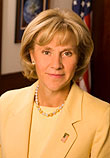|

Remarks


Credit: Sam Kittner/kittner.com
|
Dr. Kathie L. Olsen
Deputy Director
Chief Operating Officer
National Science Foundation
Biography
House of Sweden Innovation and Technology Seminar
Understanding the Brain through Informatics: INCF @ Karolinska
March 7, 2008 |
Event Program (PDF 57KB)
Good afternoon! It's a pleasure to see everyone here today for what promises to be an informative and interesting seminar.
First of all, I want to extend my thanks to Ms. Caroline Vicini, the Charge d'Affaires, as well Ambassador Jonas Hafstrom and the entire House of Sweden team for everything they've done to organize this seminar.
I'd also like to thank the Swedish Institute for Growth Policy Studies for their planning and support, as well as the NSF staff who helped make this event possible, Bonnie Thompson from OISE, Ann Carlson, and the many others.
The House of Sweden Innovation and Technology series is highly regarded in Washington, and it’s wonderful to see neuroinformatics included in a list of such fascinating topics!
I'm really honored to share the podium with Professor Sten Grillner, and I want to thank him as well for his efforts in organizing this seminar.
Under Sten's leadership, the INCF at Karolinska is on track to becoming the nexus of neuroinformatics activities for the entire global community. At NSF, we're proud to contribute to INCF and we're excited for what the future holds.
And, I'm really pleased that Alan Leshner agreed to moderate the discussion in the second half of today's seminar. Dr. Leshner has been a leader in brain science in the United States for many years and it's quite an honor to have him with us today.
The 1990's have been called the 'Decade of the Brain' as powerful imaging techniques made it possible for us to visualize brain activities in unprecedented detail. The science advanced in leaps and bounds as discoveries piled up, almost faster than anyone could keep track.
With these technological achievements came a tremendous amount of data. It became clear that informatics, the science of information, could help neuroscience researchers work with their own data and share data with other groups, using standardized methods.
The marriage of neuroscience and informatics is bringing our understanding of the brain to an entirely new level. Already, we are seeing the benefits of data sharing and collaboration across disciplinary and national boundaries.
Neuroinformatics also facilitates good communication between basic and applied research. New discoveries can now transition more quickly to the clinical and industrial communities – speeding the time it takes us to understand and combat disease.
NSF funds research that has the potential to revolutionize existing fields, catalyze the creation of new sub-disciplines, and cause paradigm shifts. We are also constantly working to increase the benefits of research to society.
Neuroinformatics is a perfect fit for our agency! We have a broad computational portfolio to complement our neuroscience efforts.
There are exciting new opportunities to discuss, as I'm sure we'll find out in today's presentations and panels.
We have some very distinguished presenters with us today, and I'm honored to introduce the first set of them now.
Gordon Shepherd is a Professor of Neuroscience and Neurobiology at the Yale University School of Medicine.
Professor Shepherd has made important contributions to our understanding of the synaptic organization of the brain. His current research focuses on olfaction, at the level of dendrites, dendritic spines, and synapses, mostly in the olfactory bulb.
Professor Shepherd heads the SenseLab Project at Yale, a long-term effort to build integrated, multidisciplinary models of neurons and neural systems. SenseLab uses the olfactory pathway as a model system. Dr. Shepherd has been an author and contributor to several important books in neuroscience.
Robert "Bob" Williams is a Professor in the Department of Anatomy and Neurobiology at the University of Tennessee, and holds the Dunavant Professorship in developmental genetics in the Department of Pediatrics.
Professor Williams is the co-director of the Center of Genomics and Bioinformatics at the University of Tennessee. He is the recipient of the 2007 Distinguished Scientist Award from the International Behavioural and Neural Genetics Society.
His research interests are in systems genetics, complex trait analysis, and functional genomics; control of gene expression; genetics of CNS diseases and addiction; visual system structure, function, and development; and advanced methods in collaborative research and data interchange.
The Williams Lab hosts the Mouse Brain Library, an impressive example of how brain information can be organized and made useful to an entire community using the Internet.
Next let's meet, Maryanne Martonem, Professor-in-Residence in the Department of Neurosciences and Co-director of the National Center for Microscopy and Imaging Research at the University of California, San Diego.
Dr. Martone has been leading the development of databases for light and electron microscope data. Her work has led to new techniques and software tools to acquire and present this data. She was a major contributor in the creation of the Cell-Centered Database, one of the first Internet databases for cell-level structural data. Her defining work on the CCDB and neuroinformatics in general has brought the Martone group international recognition.
Dr. Martone's work includes the central nervous system (CNS) morphology, protein localization, imaging of neurons and their processes, neuronal alterations that occur because of ischemia, and the growing field of neuroinformatics.
And finally, it's my pleasure to introduce Professor Anders Lansner, the Head of the Department of Computational Biology at the Royal Institute of Technology in Stockholm. He is the group leader of Computational Biology & Neurocomputing at the Royal Institute of Technology. Anders leads the computational neuroscience platform of the Stockholm Brain Institute (SBI) and the Swedish INCF node.
Professor Lansner specializes in computational neuroscience and brain-like computing. The Computational Biology & Neurocomputing group's research activities extend from artificial neural network and neurocomputing to biological modeling of neural systems.
Thank you.
|











